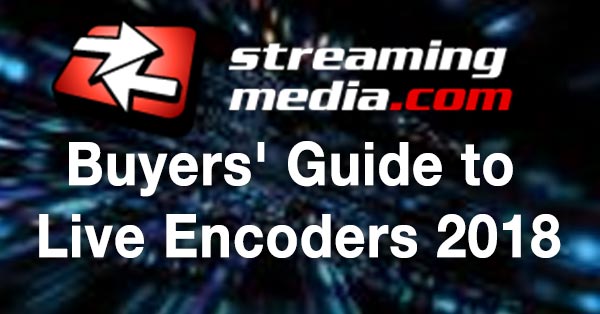Buyers’ Guide to Live Encoders 2018 | Streaming Media
By Jim Bask
 While nearly any encoder can connect to any streaming service, some encoders make it easier than others. Here’s how to choose the right tool for the job. By Jan Ozer
While nearly any encoder can connect to any streaming service, some encoders make it easier than others. Here’s how to choose the right tool for the job. By Jan Ozer You’re new to live event streaming, but you know how to use a camcorder, so the event planner put you in charge of streaming the event to Facebook Live, YouTube Live, or a similar service. You’re wondering, “What the heck do I need to get the stream to the service?” Fortunately for you, you’ve got a lot of options, which we’ll cover in this article.
There are many ways to segment these options, but we’re focusing on three scenarios. In the first, you have Ethernet and power and are shooting with a single camera; in the second, you have Ethernet and power and are shooting with multiple cameras; and in the third you have neither Ethernet nor power and are shooting with a single camera.
The Basics of Connecting
Before we get started, there’s one techie thing you need to know. That is, excepting encoders purpose-built for a single service, any encoder should be able to communicate with any service. How easy it is to connect to that service will vary from encoder to encoder.
Specifically, to connect to any service, you’ll need to provide the server URL and a stream name to your encoder. With some encoders, you’ll have to manually type in the server URL and stream name, and perhaps even a login name and password. It’s not rocket science, but it can be a pain when adding letters, numbers, and symbols via a device joystick and buttons, which never seems to go right the first time. You may also have to manually configure parameters like resolution and data rate of the encoded stream.
Encoders that you can access via a computer or mobile device will usually let you log in to the service and then manage credentials automatically in the background. During this process, the encoder will also select an encoding template that’s customized for the service, simplifying the process. Again, the high-level message is that almost all encoders can connect to all services, but some encoders make it easier than others.
Wi-Fi/Power/Single Camera
This is the most common scenario—a simple shoot from within a conference or meeting room, or perhaps at an off-site location. Either way, you’re shooting with a single camera, with access to power, connectivity, and space to set up your gear. Here’s an overview of your options.
CHECK THE CAMCORDER
Many camcorders now include Wi-Fi connectivity and the ability to encode and stream directly to a service. These devices can work well, but there are several caveats.
First, most live event producers prefer wired connections over Wi-Fi, which is often is shared with other users. Outbound bandwidth is absolutely critical to your streaming video, so if you can’t guarantee unshared access to the Wi-Fi, you may be better off with a wired device. Note that some camcorders have USB ports that can support either a Wi-Fi or Ethernet dongle; if you have a choice, go for the latter….[continue reading]

